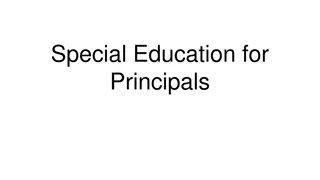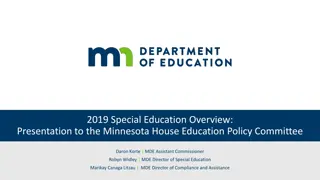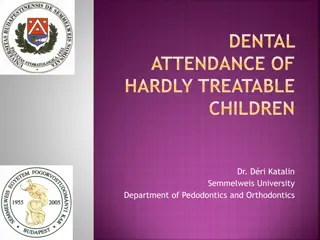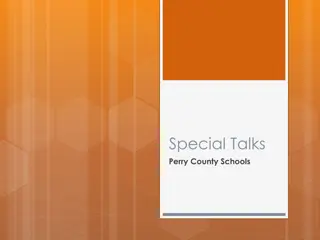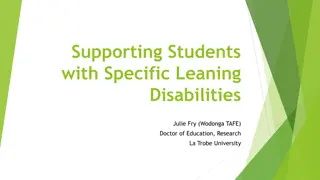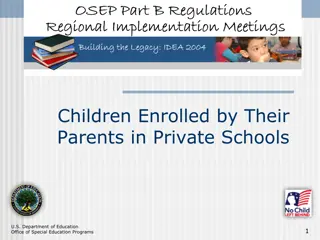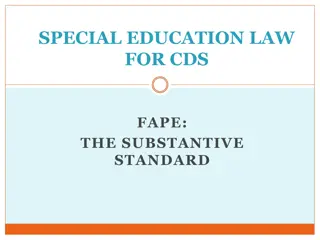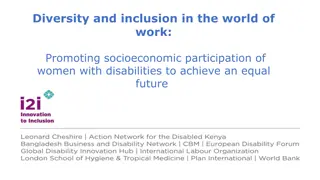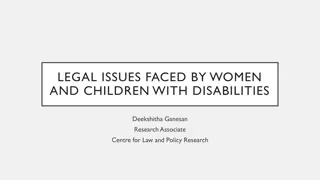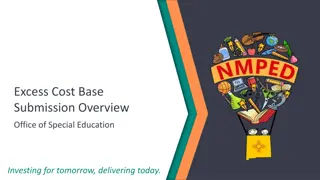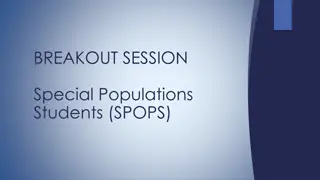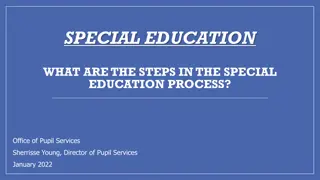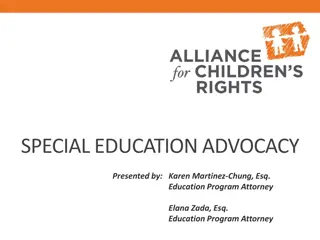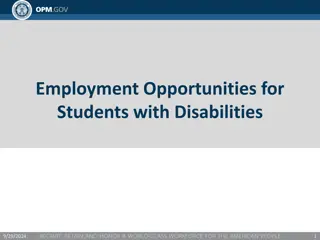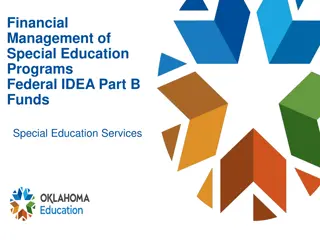Understanding Multiple Disabilities in Special Education
Multiple disabilities refer to the presence of two or more impairments that significantly impact educational performance, leading to challenges in standard special education settings. This includes various combinations of disabilities such as mental retardation, blindness, orthopedic impairment, and others. Children with multiple disabilities may require high support needs due to the severity and complexity of their conditions. Proper assessment, classification, and understanding of their needs are crucial for providing effective education and support.
Download Presentation

Please find below an Image/Link to download the presentation.
The content on the website is provided AS IS for your information and personal use only. It may not be sold, licensed, or shared on other websites without obtaining consent from the author. Download presentation by click this link. If you encounter any issues during the download, it is possible that the publisher has removed the file from their server.
E N D
Presentation Transcript
MULTIPLE DISABILITY P . KAMARAJ, Faculty , NIEPMD, ECR ,Muttukadu , Chennai Kamaraj_nimh@yahoo.com 9840380628
TNTEU , B.Ed SPECIAL EDUCATION PROGRAM Course 5 : Assessment and Identification of Needs of Persons with Multiple Disabilities Unit III : Multiple Disabilities and other disability conditions Sub Unit 3.1 : Multiple Disabilities Meaning , Definitions and classifications Sub Unit 3.2 : Various combinations of Multiple Disabilities and Associated conditions such as epilepsy motor and sensory condition Sub Unit 3.3 : Implication of Functional limitations for Education of children with multiple disabilities
MULTIPLE DISABILITIES children with multiple disabilities are often called Severe handicapped Severely and profoundly handicap Dual sensory impaired Additional disabilities Multiple disabilities
DEFINITION Multiple disabilities means concomitant impairments (such as mental retardation- blindness, mental retardation orthopedic impairment), the combination of which causes such severe educational problems that the students cannot be accommodated in Special Education program solely for one of the impairment. The term does not include students with deaf-blindness - USOSE (2004)
DEFINITION Multiple Disability mean a combination of two or more disabilities as defined in clause (i) of section (2) of the Persons with Disabilities (Equal Opportunities, Protection of Rights and Full Participation) Act 1995
DEFINITION Those children excluded from school on the basis of extensive mental, physical, and or behavioral impairments that are permanent in nature
CLASSIFICATIONS The classification of children with Multiple Disabilities are based on the combinations and severity Moderate , Severe & Profound condition of any one of the disability in the combination makes the person become multiple disabilities. In the diagnostic assessment and evaluation process it is addressed that the impairment or the disability condition is more than 60 % among the bench mark disabilities become multiple disabilities in turn they are also called as the children having high support needs.
THE COMBINATIONS OF MULTIPLE DISABILITIES The children with Multiple disabilities may be reported with various combinations as given below A child may have reported with concomitant impairment of Intellectual and locomotor disability or A child may have reported with concomitant impairment of Intellectual and sensory disability or A child may have reported with concomitant impairment of Intellectual and any other developmental disabilities Such as Intellectual Disability (ID) + Autism Spectrum Disorders (ASD) , ID + Cerebral Palsy (CP) ID+ Deafblind(DB) or DB or ASD+ DB or CP+DB etc.
CHARACTERISTIC FEATURE General appearance Self help activities Motor function Language & Communication Sensory Learning Social and Emotional Physical/Health condition
GENERAL APPEARANCE Under build / Thin built Unsteady of body control Clumsiness of appearance Micro cephalic or hydro cephalic head Squint Pigeon chest Drools Asymmetrical body features Flexed or Drooped body condition Retarder physical growth
MOTOR FUNCTIONS Presence of abnormal reflexes Unstable body condition No active movements of body and limbs Developing abnormal pattern of posture and movements Flexion and hyper tonicity of joins and muscles Extended or Hypo tonicity of joins and muscles Sits or stands with supports Lying on the floor or bed for long time Drags the body for movements Depend on others for his mobility Carries by others manually or using a wheel chair Hesitate to move around and experiences of fall or hurt while moving around
SELF HELP ACTIVITIES Poor oral hygiene Decay of the tooth Show feeble movement of feeding Shows difficulties in sucking , swallowing , biting and chewing Poor intake Chokes while feeding Poor toilet skill , no toilet indication, cries after defecation and urination Cooperates for brushing , bathing and dressing. Custodial of other for his self help activities Vulnerable to gets infected due to poor maintenance of his clothes, body and places
LANGUAGE AND COMMUNICATION Severe to profound delay in language and communication development Very poor in using the body or limbs for communication Cries or coos or vocalises for communication Uses minimal facial expression for communication Uses eye gazing for communication Shows agitate movement or moves his limbs for communication Depend on AAC
SENSORY Presence of sensory impairment Uses residual senses for the functional activities Shows hyper or hyposensitivity in one or more of the seven senses Does not use effectively the sensory modalities for learning Poor abstraction Does not involve effectively the metacognitive process for learning Doesn't get much opportunity for learning. Poor anticipation and reactions Hesitates to explore with environment /surroundings
SOCIAL AND EMOTIONAL Looks Fearful Gets frustrated , angry and upset that can be observed in the face. Have difficulty forming interpersonal relationship No or hardly any friends Doesn t react immediately any emotional situations Does not able participate effectively in the games and play No or minimal exposed to the visitors and other community functions Poor maintenance of his body , clothes and surroundings Not able to defend or indicate on certain circumstances and Victim of ant bites , mosquitoes bites or any other insect bites.
LEARNING Has poor gross fine motor movements Uses his/her residual senses for learning Shows very poor or lethargic response to stimuli Shows poor visual, auditory ,tactile and kinesthetic processing skills Forgets skills through disuse Has limited abstract thinking Difficulty in locating the directions of sound Difficulties in visual tracking and visual discrimination Exposed to limited environment for learning Experience of being isolated at home or at other places
HEALTH Febrile convulsion or Seizures / Epileptic conditions may be having Simple , Partial to Complex seizures Metabolic disorders liken MPS I&II ,PKU etc. Undernourished /Malnourished Constipation sometimes bleedings Sensory loss loss of hearing threshold and visual acuity and poor reflexarc Hydrocephalus and scoliosis Physically clumsy and awkward No reactions to various sensory insults like hot or cold contacts , spicy or any other tastes , bad smells.
ASSESSMENT TO UNDERSTAND THE BIO-BEHAVIOURL STATE BIO BEHAVIOURAL STATE It has 3 parts A-Behavior state B-Learning environment C- Format for recording the data
ASSESSMENT BEHAVIOR STATE: Sleep states Intermediate state Preferred awake stage Other awake stage
ASSESSMENT LEARNING ENVIRONMENT VARIABLES: Materials Modality Activity Social contact Position Environmental/Setting
ASSESSMENT FORMAT FOR RECORDING: 30 observation records to be made in each data sheets
THE SIGNIFICANCE OF BBS ASSESSMENT The BBS assessment will help special educators and the therapist to understand to find the right time ( Active Alert Time) for providing the intervention and to avoid certain times for the child to take rest. It also provide the information on engaging the child for intervention with the right persons , the materials preferred by the child to learn in the appropriate place and context.
IMPLICATION OF LEARNING Children with multiple disabilities are experiencing various difficulties in performing their activity of daily living , using their motor skills effectively , learning the content like any other children , communicating with others effectively. The also have the difficulties in using the space and establishing the social relationship with others. The BBS gives the directions to understand the feasibilities of using the active time, place , persons and the materials for planning the intervention program The program checklist which is developed by NIEPID (formerly called NIMH) for children with Profound Intellectual Disability is found to be useful for developing the functional activities to enable them to live as closely as possible with their family and community. The support Intensity program developed by American Association of Intellectual and Developmental Disability (AAIDD) provides a meaningful direction to the special education teachers , therapist and the parents to develop appropriate supports to perform the skills.
FACP PMR ASSESSMENT It has 4 sections Section A covers checklist of skills Section B covers checklist of problem behavior Section C coves checklist of general problems Section D covers progress report
SKILLS IDENTIFIED FOR FACILITATING THE LEARNING OF CHILDREN WITH SEVERE AND PROFOUND INTELLECTUAL DISABILITIES (MULTIPLE DISABILITIES) 1.Eating Skills -14 Items identified 2.Drinking Skills-8 items identified 3.Toileting skills-16 items identified 4.Dressing Skills-9 items were identified 5.Motor skills -36 items identified 6.Communication Skills-19 items identified 7.Social Skills-12 items identified 8.Visual Skills-10 items identified
INDIVIDUALISED CARE AND TRAINING PLAN Sl No Activity Current Level Positioning Procedure Material Evaluation Remarks
ASSESSMENT ON SUPPORT INTENSITY NEED IN VARIOUS AREAS SUPPORT INTENSITY NEED ANALYSIS USING SIS Home living activities Community and Neighborhood activities School Participation Activities School Learning Activities including the use of technology Health and Safety Activities Advocacy Activities Medical & Behavioural Other assessment related to Physical therapy , occupational therapy and the Speech therapy will have its own schedule to follow.
ASSESSMENT ON SCHOOL PARTICIPATION ACTIVITIES School participation activities: Examples Being included in general education class room including the library and technology rooms Participating in activities in common school areas (e.g . play ground hall ways ,cafeteria) Participating in co-curricular Getting to school (includes accessible transportations) Moving around with in the school and transitioning between activities Facilities for Participating in large scale test taking activities required by state education system. Following class room and school rules Keeping track of personnel belongings at school & Keeping track of schedule at school Barrier free Space for the children with multiple disability to participate in activates
ASSESSMENT ON SCHOOL LEARNING ACTIVITIES School learning activities: Example Appropriate seating arrangements for learning Accessing grade level curriculum content and curriculum access Learning academic skills using assistive technologies Learning and using metacognitive skills Completing academic tasks using assistive technology Learning how to use and using problem solving and self regulation strategies in the class room Participating in class room level evaluation such as tests in flexible way Accessing health and physical education curricula Completing homework assignment
SCORE ON MEDICAL AND BEHAVIOURAL ACTIVITIES Medical and Behavioural activities: 0= No support needed 1 = some support needed (i.e., providing monitoring and /occasional assistance) 2 = Extensive support needed (i.e., providing regular assistance to manage the medical condition or behavior)
TYPES OF SUPPORT REQUIRES 0=None 1=Monitoring 2=Verbal/gestural prompting 3=Partial Physical assistance 4=Full Physical Assistance
FREQUENCY OF SUPPORT REQUIRES 0=Negligible 1=Infrequently 2=Frequently 3=Very frequently 4=Always
DAILY SUPPORT TIME REQUIRES 0=None 1=Less than 30 Minutes 2=30 Minutes to less than 2 hours 3=2 Hours to less than 4 Hours 4=4Hours or More
INDIVIDUALISED SUPPORT PLAN Based on the intensity of support needed on the type of support , frequency , time and support required for medical and behavioural aspect the resources are developed in the process of Individualised Support Plan The individualised support plan is focused on successful achievement of the activities targeted for the child with all kind of supports This support plan does not give importance on the activities which the children shows unsuccessful.
REFERENCES Individuals with Disability Education Act (2004) United States Myreddy.V., Narayan .J.(2004)FACP PMR .NIEPID (formerly NIMH) .Secunderabad. AAIDD(2016). Support Intensity Scale.US


